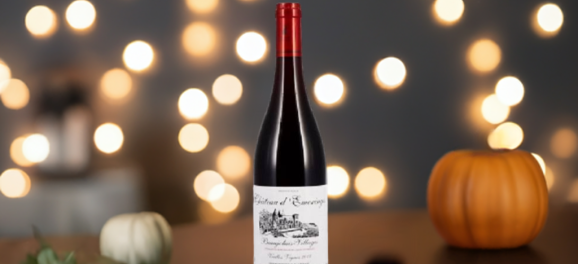What to drink when the nights draw in?

You know the script. Any hopes of an Indian summer have long since faded, and the prospect of returning home from work in the pitch-black looms larger than Oliver Reed’s drinks cabinet. Maybe you’ve tried, but quaffing rosé in the autumn wind just doesn’t cut it. Time for some new wines, perhaps? You might be expecting a shopping list full of big, heavy options, but we have something altogether different up our wool-wrapped sleeves. That something is Beaujolais – and it is better than you think!
Beaujolais, like its neighbour, Burgundy, has a cru system, and is therefore an area of quality production. In all, there are 10 crus. From north to south, these are Saint-Amour, Juliénas, Chénas, Moulin-à-Vent, Fleurie (most of us know this one), Chiroubles, Morgon, Régnié, Brouilly, and lastly, Côte de Brouilly. All are made from Gamay (which has a particular affinity with the region’s granitic soils), with genuine differences in how they taste. Admittedly, cru wines can sometimes taste very similar, although the keen of palate will detect darker fruits (and more structure) in the bigger crus of Morgon and Moulin-à-Vent, while the likes of Régnié and Brouilly (oh, that perennial Parisian favourite!) tend towards quaffable and strawberry-laced.
So, we have established that Beaujolais has a bit of gold trim. What gives it such a signature taste? Most Beaujolais is made by a process called semi-carbonic maceration. In layman’s terms, this means that instead of being pressed, whole bunches of grapes are left to break down internally in the presence of rising carbon dioxide, the bottom berries splitting under the weight of the top fruit and fermenting in a more orthodox manner (both the lack of a hermetic seal and inclusion of this latter ferment contribute to the ‘semi’ prefix). The process reduces Gamay’s high malic acid content, minimises tannins, and really emphasises fruitiness, creating the supple, easy going, often bubble-gum tasting wine that we know and love! Consequently, Beaujolais is best enjoyed in its youth, although some examples do stand the test of time.
Value, value! That is what Beaujolais brings. Pricing is never steep, but come away from the crus, and it is even keener. At York Wines, we have selected a Vieilles Vignes (literally ‘old vines’, lending much nuance) and gold medal-medal winning Cuvee Fruitée, by Château d’Émeringes. This family-owned estate is run by third-generation Pierre David from his chic 19th century home southwest of Juliénas, built in the style of Napoleon III. He manages fifteen hectares of vines up to forty years old, and his wines perform superbly in their category.
Here is a secret: Beaujolais is one of the very few tipples that genuinely tastes good out of a paper cup (an inspired choice for Halloween!). Its mellow nature is a winner for building up the party atmosphere, while it even tastes great warmed up. It may not be the ideal match for toffee apples, but we can’t have everything. Beaujolais does acquit itself exceptionally well with cheeses, however, especially fondue, where its freshness serves to counter the richness. It is an excellent match for dishes as diverse as curry and paella (for which it can be lightly chilled to combat the kind of tricky spiciness that lays more structured reds to waste).
And, guess what? November is Beaujolais Nouveau month! The concept may be genius marketing on the part of the French, but who can argue with a bit of joie de vivre? There is something heart-warming about celebrating harvest with just made wines, and what if some of them actually turned out to be genuinely good? ‘Yeah, right!’ we hear you say, but honestly, honestly, this is what we found out when cracking our Château d’Émeringes Beaujolais Nouveau ten months after the release date. It was supremely concentrated and laden with masses of ripe red berry fruit, deftly supported by spritely acidity. And here is another secret: far from shipping their bottles across the Channel with a Gallic grin, the French actually love Beaujolais. Every October, the supermarket E. Leclerc in Épernay holds a big ‘Foire aux Vins’ (which we visited this year) and Beaujolais flies off the shelf faster than any other red wine. Even M. Pierre, the shrewd and indisputably gourmand supermarket boss, drinks it in droves. Well, there you have it: want to drink like the French? Pop that Beaujolais cork.
Our 2024 Beaujolais Nouveau will be hitting the shelves on Thursday 21st November

